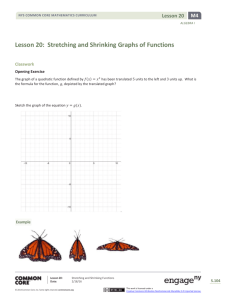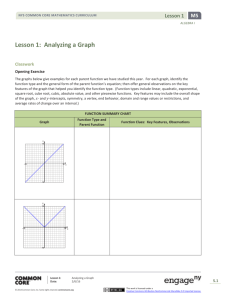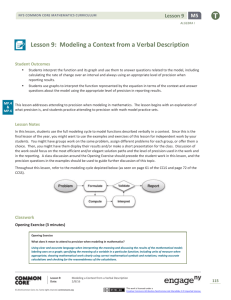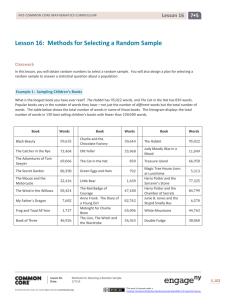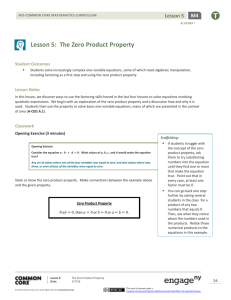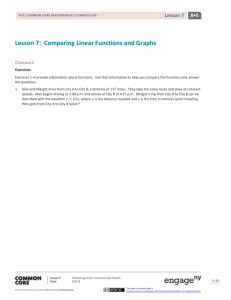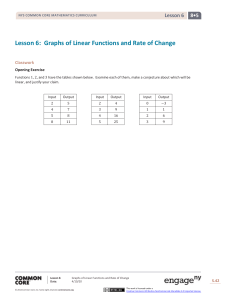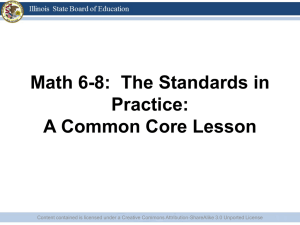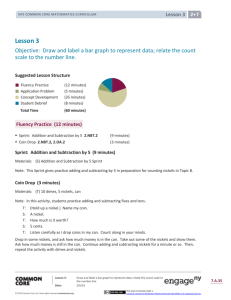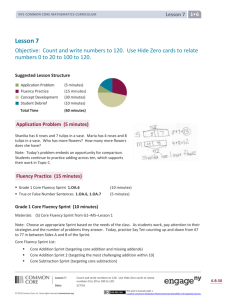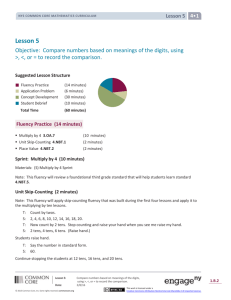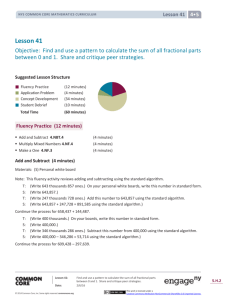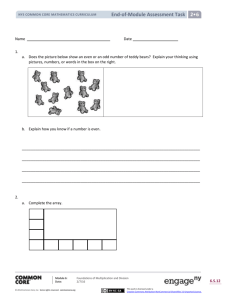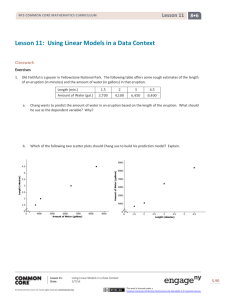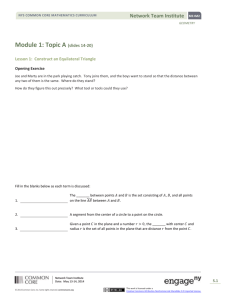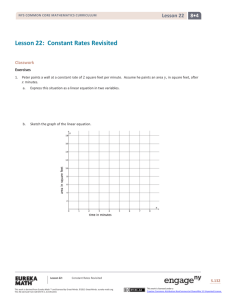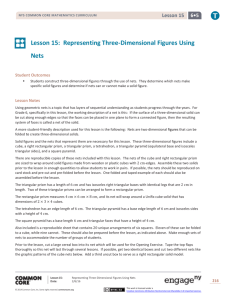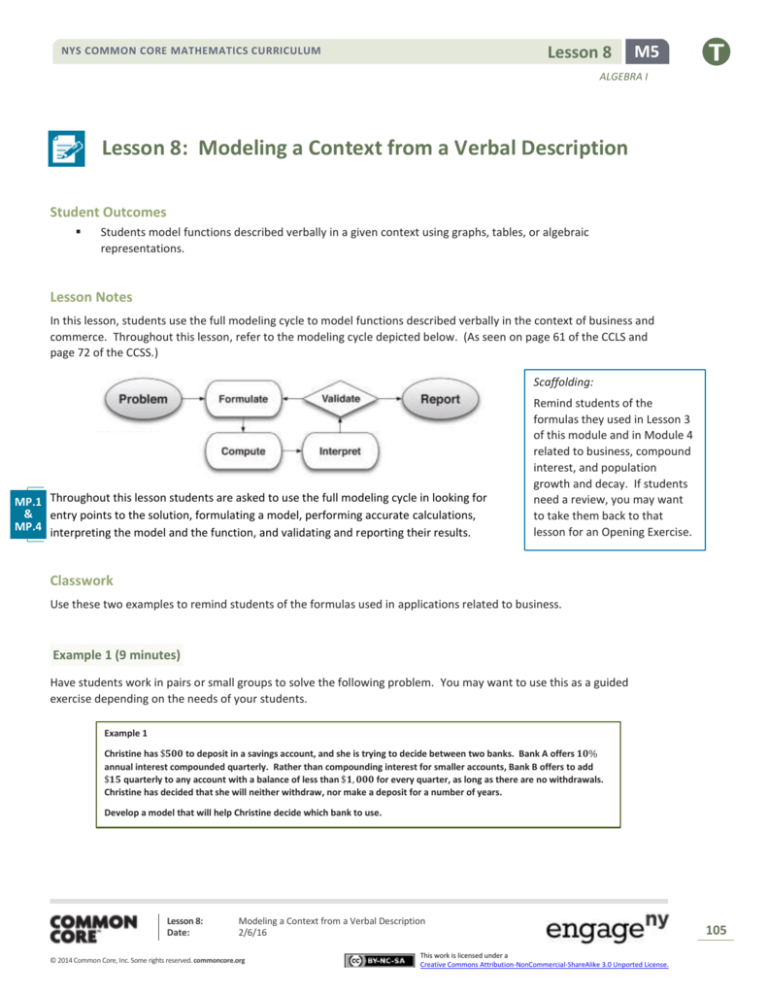
Lesson 8
NYS COMMON CORE MATHEMATICS CURRICULUM
M5
ALGEBRA I
Lesson 8: Modeling a Context from a Verbal Description
Student Outcomes
Students model functions described verbally in a given context using graphs, tables, or algebraic
representations.
Lesson Notes
In this lesson, students use the full modeling cycle to model functions described verbally in the context of business and
commerce. Throughout this lesson, refer to the modeling cycle depicted below. (As seen on page 61 of the CCLS and
page 72 of the CCSS.)
Scaffolding:
MP.1 Throughout this lesson students are asked to use the full modeling cycle in looking for
& entry points to the solution, formulating a model, performing accurate calculations,
MP.4 interpreting the model and the function, and validating and reporting their results.
Remind students of the
formulas they used in Lesson 3
of this module and in Module 4
related to business, compound
interest, and population
growth and decay. If students
need a review, you may want
to take them back to that
lesson for an Opening Exercise.
Classwork
Use these two examples to remind students of the formulas used in applications related to business.
Example 1 (9 minutes)
Have students work in pairs or small groups to solve the following problem. You may want to use this as a guided
exercise depending on the needs of your students.
Example 1
Christine has $𝟓𝟎𝟎 to deposit in a savings account, and she is trying to decide between two banks. Bank A offers 𝟏𝟎%
annual interest compounded quarterly. Rather than compounding interest for smaller accounts, Bank B offers to add
$𝟏𝟓 quarterly to any account with a balance of less than $𝟏, 𝟎𝟎𝟎 for every quarter, as long as there are no withdrawals.
Christine has decided that she will neither withdraw, nor make a deposit for a number of years.
Develop a model that will help Christine decide which bank to use.
Lesson 8:
Date:
Modeling a Context from a Verbal Description
2/6/16
© 2014 Common Core, Inc. Some rights reserved. commoncore.org
This work is licensed under a
Creative Commons Attribution-NonCommercial-ShareAlike 3.0 Unported License.
105
Lesson 8
NYS COMMON CORE MATHEMATICS CURRICULUM
M5
ALGEBRA I
Students may decide to use a table, graph, or equation to model this situation.
For this situation, a table allows us to compare the balances at the two banks.
Here we see that Bank B has a higher balance until the fourth year.
At Year End
Bank A Balance
Bank B Balance
Year 1
$551.91
$560
Year 2
$609.20
$620
Year 3
$672.44
$680
Year 4
$742.25
$740
Scaffolding:
If students need some scaffolding for
this example, you might try breaking
down the entry to the problem into
steps. For example, the first question
might be
How will we use the fact that the
interest is compounded quarterly
when we create the model?
We might be tempted to just say that at more than 3 years, Bank A is better. If
students reach this conclusion, use the following line of questioning:
Can we give a more exact answer? Since the interest is compounded
quarterly, we may want to consider the quarters of year 3. If after
choosing a bank, Christine wanted to make sure her money was earning
as much as possible, after which quarter would she make the
withdrawal?
Then, walk students through the
solution steps.
Since the balances intersect in year 4, we can look at the balances for each quarter of that year:
Year 3—Quarters
Bank A
Bank B
Year 3
$672.44
$680
1st
$689.26
$695
2nd
$706.49
$710
3rd
$724.15
$725
th
$742.25
$740
4
In the formula for
compounded interest, we will
use 4𝑡 for the exponent since
the interest will be
compounded 4 times each
year. And we will divide the
annual interest rate of 10%
by 4.
We can see from this table that it is not until the 4th quarter that Bank A begins to make more money
for Christine. If she chooses Bank A, she should leave her money there for more than 3 years and 9
months. If she chooses Bank B, she should withdraw before the 4th quarter of Year 3.
Note: If students prefer to use the function as a model for Example 1:
Bank A: 𝑨(𝒕) = 𝟓𝟎𝟎 (𝟏 +
𝟎.𝟏𝟎 𝟒𝒕
) or 𝟓𝟎𝟎(𝟏. 𝟎𝟐𝟓)𝟒𝒕
𝟒
Bank B: 𝑩(𝒕) = 𝟓𝟎𝟎 + 𝟔𝟎𝒕 (Since her money earns $𝟏𝟓 quarterly, then $𝟏𝟓(𝟒) = $𝟔𝟎 a year.)
Lesson 8:
Date:
Modeling a Context from a Verbal Description
2/6/16
© 2014 Common Core, Inc. Some rights reserved. commoncore.org
This work is licensed under a
Creative Commons Attribution-NonCommercial-ShareAlike 3.0 Unported License.
106
Lesson 8
NYS COMMON CORE MATHEMATICS CURRICULUM
M5
ALGEBRA I
Example 2 (9 minutes)
Example 2
Alex designed a new snowboard. He wants to market it and make a profit. The total initial cost for manufacturing set-up,
advertising, etc. is $𝟓𝟎𝟎, 𝟎𝟎𝟎, and the materials to make the snowboards cost $𝟏𝟎𝟎 per board.
The demand function for selling a similar snowboard is 𝑫(𝒑) = 𝟓𝟎, 𝟎𝟎𝟎 − 𝟏𝟎𝟎𝒑, where 𝒑 = selling price of each
snowboard.
a.
Write an expression for each of the following. Let 𝒑 represent the selling price:
Demand Function (number of units that will sell)
This is given as 𝟓𝟎, 𝟎𝟎𝟎 − 𝟏𝟎𝟎𝒑.
Revenue [(number of units that will sell)(price per unit, 𝒑)]
(𝟓𝟎, 𝟎𝟎𝟎 − 𝟏𝟎𝟎𝒑)𝒑 = 𝟓𝟎, 𝟎𝟎𝟎𝒑 − 𝟏𝟎𝟎𝒑𝟐
Total Cost (cost for producing the snowboards)
This is the total overhead costs plus the cost per snowboard times the number of snowboards:
𝟓𝟎𝟎, 𝟎𝟎𝟎 + 𝟏𝟎𝟎(𝟓𝟎, 𝟎𝟎𝟎 − 𝟏𝟎𝟎𝒑)
𝟓𝟎𝟎, 𝟎𝟎𝟎 + 𝟓, 𝟎𝟎𝟎, 𝟎𝟎𝟎 − 𝟏𝟎, 𝟎𝟎𝟎𝒑
𝟓, 𝟓𝟎𝟎, 𝟎𝟎𝟎 − 𝟏𝟎, 𝟎𝟎𝟎𝒑
b.
Write an expression to represent the profit.
𝐏𝐫𝐨𝐟𝐢𝐭 = 𝐓𝐨𝐭𝐚𝐥 𝐑𝐞𝐯𝐞𝐧𝐮𝐞 − 𝐓𝐨𝐭𝐚𝐥 𝐂𝐨𝐬𝐭 [𝒇(𝒑)]
(𝟓𝟎, 𝟎𝟎𝟎𝒑 − 𝟏𝟎𝟎𝒑𝟐 ) − (𝟓, 𝟓𝟎𝟎, 𝟎𝟎𝟎 − 𝟏𝟎, 𝟎𝟎𝟎𝒑)
Therefore, the profit function is 𝒇(𝒑) = −𝟏𝟎𝟎𝒑𝟐 + 𝟔𝟎, 𝟎𝟎𝟎𝒑 − 𝟓, 𝟓𝟎𝟎, 𝟎𝟎𝟎.
c.
What is the selling price of the snowboard that will give the maximum profit?
Solve for the vertex of the quadratic function using completing the square.
𝒇(𝒑) = −𝟏𝟎𝟎𝒑𝟐 + 𝟔𝟎, 𝟎𝟎𝟎𝒑 − 𝟓, 𝟓𝟎𝟎, 𝟎𝟎𝟎
) − 𝟓, 𝟓𝟎𝟎, 𝟎𝟎𝟎
= −𝟏𝟎𝟎(𝒑𝟐 − 𝟔𝟎𝟎𝒑 +
= −𝟏𝟎𝟎(𝒑𝟐 − 𝟔𝟎𝟎𝒑 + 𝟑𝟎𝟎𝟐 ) − 𝟓, 𝟓𝟎𝟎, 𝟎𝟎𝟎 + 𝟏𝟎𝟎(𝟑𝟎𝟎)𝟐
= −𝟏𝟎𝟎(𝒑 − 𝟑𝟎𝟎)𝟐 − 𝟓, 𝟓𝟎𝟎, 𝟎𝟎𝟎 + 𝟗, 𝟎𝟎𝟎, 𝟎𝟎𝟎
= −𝟏𝟎𝟎(𝒑 − 𝟑𝟎𝟎)𝟐 + 𝟑, 𝟓𝟎𝟎, 𝟎𝟎𝟎
So, the selling price that will yield the maximum profit is at 𝒑 = $𝟑𝟎𝟎.
d.
What is the maximum profit Alex can make?
According to the vertex form, the maximum profit would be $𝟑, 𝟓𝟎𝟎, 𝟎𝟎𝟎 for selling at a price of $𝟑𝟎𝟎 for each
snowboard.
Lesson 8:
Date:
Modeling a Context from a Verbal Description
2/6/16
© 2014 Common Core, Inc. Some rights reserved. commoncore.org
This work is licensed under a
Creative Commons Attribution-NonCommercial-ShareAlike 3.0 Unported License.
107
Lesson 8
NYS COMMON CORE MATHEMATICS CURRICULUM
M5
ALGEBRA I
Exercises (20 minutes)
Have students work in pairs or small groups to solve the following two exercises. You may anticipate the needs of your
students by heading off any issues you foresee arising in these problems. For example, in part (d) of the first exercise,
students will need to model using a table of values or a graph since they are not experienced with solving exponential
equations. You may need to remind them that sometimes a table is the preferred model for solving a problem since
graphs often require rough estimates. They may need to set up a program in their calculator or use a spreadsheet.
Calculators and/or graph paper are important for these exercises. Table-building and other calculations require a
scientific calculator, at the very least. For example, in part (c) of Exercise 2, students will need to take a 5th root of 2.
Exercises
Alvin just turned 𝟏𝟔 years old. His grandmother told him that she will give him $𝟏𝟎, 𝟎𝟎𝟎 to buy any car he wants
whenever he is ready. Alvin wants to be able to buy his dream car by his 21st birthday, and he wants a 2009 Avatar Z,
which he could purchase today for $𝟐𝟓, 𝟎𝟎𝟎. The car depreciates (reduces in value) at a rate is 𝟏𝟓% per year. He wants
to figure out how long it would take for his $𝟏𝟎, 𝟎𝟎𝟎 to be enough to buy the car, without investing the $𝟏𝟎, 𝟎𝟎𝟎.
1.
Write the function that models the depreciated value of the car after 𝒏
number of years.
𝒏
𝒇(𝒏) = $𝟐𝟓, 𝟎𝟎𝟎(𝟏 − 𝟎. 𝟏𝟓) or 𝒇(𝒏) = 𝟐𝟓, 𝟎𝟎𝟎(𝟎. 𝟖𝟓)
a.
After 𝒏 years
Value of the Car
𝟏
$𝟐𝟏, 𝟐𝟓𝟎
𝟐
$𝟏𝟖, 𝟎𝟔𝟐. 𝟓
𝟑
$𝟏𝟓, 𝟑𝟓𝟑. 𝟏𝟑
𝟒
$𝟏𝟑, 𝟎𝟓𝟎. 𝟏𝟔
𝟓
$𝟏𝟏, 𝟎𝟗𝟐. 𝟔𝟑
𝟔
$𝟗, 𝟒𝟐𝟖. 𝟕𝟒
𝒏
Will he be able to afford to buy the car when he turns 𝟐𝟏? Explain
why or why not.
𝒇(𝒏) = 𝟐𝟓, 𝟎𝟎𝟎(𝟎. 𝟖𝟓)𝒏
𝒇(𝟓) = 𝟐𝟓, 𝟎𝟎𝟎(𝟎. 𝟖𝟓)𝟓 = $𝟏𝟏, 𝟎𝟗𝟐. 𝟔𝟑 …
No, he will not be able to afford to buy the car in 𝟓 years because
the value of the car will still be $𝟏𝟏, 𝟎𝟗𝟐. 𝟔𝟑, and he has only
$𝟏𝟎, 𝟎𝟎𝟎.
b.
Given the same rate of depreciation, after how many years will the value of the car be less than $𝟓, 𝟎𝟎𝟎?
𝒇(𝟏𝟎) = 𝟐𝟓, 𝟎𝟎𝟎(𝟎. 𝟖𝟓)𝟏𝟎 = $𝟒𝟗𝟐𝟏. 𝟖𝟔
In 𝟏𝟎 years, the value of the car will be less than $𝟓, 𝟎𝟎𝟎.
c.
If the same rate of depreciation were to continue indefinitely, after how many years would the value of the
car be approximately $𝟏?
𝑭(𝒏) = 𝟐𝟓, 𝟎𝟎𝟎(𝟎. 𝟖𝟓)𝒏 = 𝟏
In about 𝟔𝟐 years, the value of the car is approximately $𝟏.
Lesson 8:
Date:
Modeling a Context from a Verbal Description
2/6/16
© 2014 Common Core, Inc. Some rights reserved. commoncore.org
This work is licensed under a
Creative Commons Attribution-NonCommercial-ShareAlike 3.0 Unported License.
108
Lesson 8
NYS COMMON CORE MATHEMATICS CURRICULUM
M5
ALGEBRA I
2.
Scaffolding:
Sophia plans to invest $𝟏, 𝟎𝟎𝟎 in each of three banks.
Remind students that we
used quarterly
compounding in Example 1
of this lesson.
Bank A offers an annual interest rate of 𝟏𝟐%, compounded annually.
Bank B offers an annual interest rate of 𝟏𝟐%, compounded quarterly.
Bank C offers an annual interest rate of 𝟏𝟐%, compounded monthly.
a.
b.
Write the function that describes the growth of investment for each bank in 𝒏 years.
Bank A
𝑨(𝒏) = 𝟏𝟎𝟎𝟎(𝟏. 𝟏𝟐)𝒏
Bank B
𝑩(𝒏) = 𝟏𝟎𝟎𝟎 (𝟏 +
𝟎.𝟏𝟐 𝟒𝒏
) or 𝟏𝟎𝟎𝟎(𝟏. 𝟎𝟑)𝟒𝒏
𝟒
Bank C
𝑪(𝒏) = 𝟏𝟎𝟎𝟎 (𝟏 +
𝟎.𝟏𝟐 𝟏𝟐𝒏
) or 𝟏𝟎𝟎𝟎(𝟏. 𝟎𝟏)𝟏𝟐𝒏
𝟏𝟐
Depending on the needs of
your students, you may
want to do a scaffolded
introduction to this
problem, helping them get
the set up, and maybe
even discuss the functions.
How many years will it take to double her initial investment for each bank? (Round to the nearest whole
dollar.)
Year
Bank A
Bank B
Bank C
Year 1
$𝟏𝟏𝟐𝟎
$𝟏𝟏𝟐𝟔
$𝟏𝟏𝟐𝟕
Year 2
$𝟏𝟐𝟓𝟒
$𝟏𝟐𝟔𝟕
$𝟏𝟐𝟕𝟎
Year 3
$𝟏𝟒𝟎𝟓
$𝟏𝟒𝟐𝟔
$𝟏𝟒𝟑𝟏
Year 4
$𝟏𝟓𝟕𝟒
$𝟏𝟔𝟎𝟓
$𝟏𝟔𝟏𝟐
Year 5
$𝟏𝟕𝟔𝟐
$𝟏𝟖𝟎𝟔
$𝟏𝟖𝟏𝟕
Year 6
$𝟏𝟗𝟕𝟒
$𝟐𝟎𝟑𝟑
$𝟐𝟎𝟒𝟕
Year 7
$𝟐𝟐𝟏𝟏
$𝟐𝟐𝟖𝟖
$𝟐𝟑𝟎𝟕
For Bank A, her money will double after 𝟕 years.
For Banks B and C, her investment will double its value during the 6th year.
c.
Sophia went to Bank D. The bank offers a “double your money” program for an initial investment of $𝟏, 𝟎𝟎𝟎
in five years, compounded annually. What is the annual interest rate for Bank D?
Given information for Bank D:
Initial investment = $𝟏, 𝟎𝟎𝟎
Number of Years = 𝟓 (She would have $𝟐𝟎𝟎𝟎 in 𝟓 years.)
Compounded annually:
𝟐 × 𝟏𝟎𝟎𝟎 = 𝟏𝟎𝟎𝟎(𝟏 + 𝒓)𝟓
𝟐𝟎𝟎𝟎 = 𝟏𝟎𝟎𝟎(𝟏 + 𝒓)𝟓
𝟐𝟎𝟎𝟎 𝟏𝟎𝟎𝟎(𝟏 + 𝒓)𝟓
=
𝟏𝟎𝟎𝟎
𝟏𝟎𝟎𝟎
𝟐 = (𝟏 + 𝒓)𝟓
Since we see that 𝟐 is the 5th power of a number, we must take the 5th root of 𝟐.
𝟓
√𝟐 = (𝟏 + 𝒓)
𝟏. 𝟏𝟒𝟖𝟕 = 𝟏 + 𝒓
𝟏. 𝟏𝟒𝟖𝟕 − 𝟏 = 𝒓
𝒓 = 𝟎. 𝟏𝟒𝟖𝟕 or 𝟏𝟒. 𝟖𝟕% [annual interest rate for Bank D]
Lesson 8:
Date:
Modeling a Context from a Verbal Description
2/6/16
© 2014 Common Core, Inc. Some rights reserved. commoncore.org
This work is licensed under a
Creative Commons Attribution-NonCommercial-ShareAlike 3.0 Unported License.
109
Lesson 8
NYS COMMON CORE MATHEMATICS CURRICULUM
M5
ALGEBRA I
Closing (1 minute)
Sometimes a graph or table is the best model for problems that involve complicated function equations.
Lesson Summary
We can use the full modeling cycle to solve real-world problems in the context of business and
commerce (e.g., compound interest, revenue, profit, and cost) and population growth and decay
(e.g., population growth, depreciation value, and half-life) to demonstrate linear, exponential, and
quadratic functions described verbally through using graphs, tables, or algebraic expressions to make
appropriate interpretations and decisions.
Sometimes a graph or table is the best model for problems that involve complicated function
equations.
Exit Ticket (6 minutes)
Lesson 8:
Date:
Modeling a Context from a Verbal Description
2/6/16
© 2014 Common Core, Inc. Some rights reserved. commoncore.org
This work is licensed under a
Creative Commons Attribution-NonCommercial-ShareAlike 3.0 Unported License.
110
Lesson 8
NYS COMMON CORE MATHEMATICS CURRICULUM
M5
ALGEBRA I
Name
Date
Lesson 8: Modeling a Context from a Verbal Description
Exit Ticket
Answer the following question. Look back at this (or other) lessons if you need help with the business formulas.
Jerry and Carlos each have $1,000 and are trying to increase their savings. Jerry will keep his money at home and add
$50 per month from his part-time job. Carlos will put his money in a bank account that earns a 4% yearly interest rate,
compounded monthly. Who has a better plan for increasing his savings?
Lesson 8:
Date:
Modeling a Context from a Verbal Description
2/6/16
© 2014 Common Core, Inc. Some rights reserved. commoncore.org
This work is licensed under a
Creative Commons Attribution-NonCommercial-ShareAlike 3.0 Unported License.
111
Lesson 8
NYS COMMON CORE MATHEMATICS CURRICULUM
M5
ALGEBRA I
Exit Ticket Sample Solutions
Answer the following question. Look back at this (or other) lessons if you need help with the business formulas.
Jerry and Carlos each have $𝟏, 𝟎𝟎𝟎 and are trying to increase their savings. Jerry will keep his money at home and add
$𝟓𝟎 per month from his part-time job. Carlos will put his money in a bank account that earns a 𝟒% yearly interest rate,
compounded monthly. Who has a better plan for increasing his savings?
Jerry’s savings:
𝑱(𝒏) = 𝟏𝟎𝟎𝟎 + 𝟓𝟎(𝒏), where 𝒏 = number of months
Carlos’s savings:
𝑪(𝒏) = 𝟏𝟎𝟎𝟎 (𝟏 +
𝟎.𝟎𝟒 𝟏𝟐𝒏
) , where 𝒏 = number of months
𝟏𝟐
Number of months
Jerry’s savings
Carlos’s savings (rounded to 2
decimal places)
𝟎
$𝟏𝟎𝟎𝟎
$𝟏𝟎𝟎𝟎
𝟏
$𝟏𝟎𝟓𝟎
$𝟏𝟎𝟒𝟎. 𝟕𝟒
𝟐
$𝟏𝟏𝟎𝟎
$𝟏𝟎𝟖𝟑. 𝟏𝟒
𝟑
$𝟏𝟏𝟓𝟎
$𝟏𝟏𝟐𝟕. 𝟐𝟕
𝟒
$𝟏𝟐𝟎𝟎
$𝟏𝟏𝟕𝟑. 𝟐𝟎
…
…
…
𝒏
𝟏𝟎𝟎𝟎 + 𝟓𝟎(𝒏)
𝟏𝟎𝟎𝟎 (𝟏 +
𝟎. 𝟎𝟒 𝟏𝟐𝒏
)
𝟏𝟐
In the short term, Jerry's plan is better; in the long term, Carlos's plan is better.
Problem Set Sample Solutions
Students will need a calculator to perform the necessary calculations for this problem set.
1.
Maria invested $𝟏𝟎, 𝟎𝟎𝟎 in the stock market. Unfortunately, the value of her investment has been dropping at an
average rate of 𝟑% each year.
a.
Write the function that best models the situation.
𝒇(𝒏) = 𝟏𝟎, 𝟎𝟎𝟎(𝟏 − 𝟎. 𝟎𝟑)𝒏 or 𝟏𝟎, 𝟎𝟎𝟎(𝟎. 𝟗𝟕)𝒏
where 𝒏 = number of years since the initial investment
b.
If the trend continues, how much will her investment be worth in 𝟓 years?
𝒇(𝒏) = 𝟏𝟎, 𝟎𝟎𝟎(𝟎. 𝟗𝟕)𝒏
𝒇(𝟓) = 𝟏𝟎, 𝟎𝟎𝟎(𝟎. 𝟗𝟕)𝟓
𝒇(𝟓) = 𝟖𝟓𝟖𝟕. 𝟑𝟒 or $𝟖, 𝟓𝟖𝟕. 𝟑𝟒
c.
Given the situation, what should she do with her investment?
There are multiple answers, and there is no wrong answer. Sample Responses:
Answer 1: After two years, she should pull out her money and invest it in another company.
Answer 2: According to experts, she should not touch her investment and wait for it to bounce back.
Lesson 8:
Date:
Modeling a Context from a Verbal Description
2/6/16
© 2014 Common Core, Inc. Some rights reserved. commoncore.org
This work is licensed under a
Creative Commons Attribution-NonCommercial-ShareAlike 3.0 Unported License.
112
Lesson 8
NYS COMMON CORE MATHEMATICS CURRICULUM
M5
ALGEBRA I
2.
The half-life of the radioactive material in Z-Med, a medication used for certain types of therapy, is 𝟐 days. A
patient receives a 𝟏𝟔 𝐦𝐂𝐢 dose (millicuries, a measure of radiation) in his treatment. (Half-life means that the
radioactive material decays to the point where only half is left.)
a.
Make a table to show the level of Z-Med in the patient’s body after 𝒏 days.
Number of days
b.
Level of Z-Med in patient
𝟎
𝟏𝟔 𝐦𝐂𝐢
𝟐
𝟖 𝐦𝐂𝐢
𝟒
𝟒 𝐦𝐂𝐢
𝟔
𝟐 𝐦𝐂𝐢
𝟖
𝟏 𝐦𝐂𝐢
𝟏𝟎
𝟎. 𝟓 𝐦𝐂𝐢
Write an equation for 𝒇(𝒏) to model the half-life of Z-Med for 𝒏 days. (Be careful here. Make sure that the
formula works for both odd and even numbers of days.)
𝒏
𝟏 𝟐
𝒇(𝒏) = 𝟏𝟔 ( )
𝟐
where 𝒏 = number of days after the initial measurement of 𝟏𝟔 𝐦𝐂𝐢.
c.
How much radioactive material from Z-Med is left in the patient’s body after 𝟐𝟎 days of receiving the
medicine?
For 𝒏 = 𝟐𝟎
𝒇(𝟐𝟎) = 𝟏𝟔(𝟎. 𝟓)𝟏𝟎
𝒇(𝟐𝟎) = 𝟎. 𝟎𝟏𝟓𝟔𝟐𝟓
After ten days, there is 𝟎. 𝟎𝟏𝟓𝟔𝟐𝟓 𝐦𝐂𝐢 of the radioactive material in Z-Med left in the patient’s body.
3.
Suppose a male and a female of a certain species of animal were taken to a deserted island. The population of this
species quadruples (multiplies by 𝟒) every year. Assume that the animals have an abundant food supply and that
there are no predators on the island.
a.
What is an equation that can be used to model the population of the species?
𝒇(𝒏) = 𝟐(𝟒)𝒏
where 𝒏 = number of years after their arrival at the island.
b.
What will the population of the species be after 𝟓 years?
After 𝒏 years
Population
𝟎
𝟏
𝟐
𝟑
𝟒
𝟓
𝟐
𝟖
𝟑𝟐
𝟏𝟐𝟖
𝟓𝟏𝟐
𝟐𝟎𝟒𝟖
In 𝟓 years, the population of the animals will reach 𝟐, 𝟎𝟒𝟖.
Lesson 8:
Date:
Modeling a Context from a Verbal Description
2/6/16
© 2014 Common Core, Inc. Some rights reserved. commoncore.org
This work is licensed under a
Creative Commons Attribution-NonCommercial-ShareAlike 3.0 Unported License.
113
Lesson 8
NYS COMMON CORE MATHEMATICS CURRICULUM
M5
ALGEBRA I
c.
Write an equation to find how many years it will take for the population of the animals to exceed 𝟏 million.
Find the number of years, either by using the equation or a table.
Using the equation: 𝟐(𝟒)𝒏 = 𝟏, 𝟎𝟎𝟎, 𝟎𝟎𝟎
𝟒𝒏 = 𝟓𝟎𝟎, 𝟎𝟎𝟎
Note: Students will likely be unable to solve this equation without
using trial and error (educated guessing). They may come up with
𝟐(𝟒)𝟗.𝟓 = 𝟏, 𝟎𝟒𝟖, 𝟓𝟕𝟔 using this method.
4.
After 𝒏 years
Population
𝟎
𝟐
𝟏
𝟖
𝟐
𝟑𝟐
𝟑
𝟏𝟐𝟖
𝟒
𝟓𝟏𝟐
𝟓
𝟐, 𝟎𝟒𝟖
𝟔
𝟖, 𝟏𝟗𝟐
𝟕
𝟑𝟐, 𝟕𝟔𝟖
𝟖
𝟏𝟑𝟏, 𝟎𝟕𝟐
𝟗
𝟓𝟐𝟒, 𝟐𝟖𝟖
𝟏𝟎
𝟐, 𝟎𝟗𝟕, 𝟏𝟓𝟐
The revenue of a company for a given month is represented as 𝑹(𝒙) = 𝟏, 𝟓𝟎𝟎𝒙 − 𝒙𝟐 and its costs as
𝑪(𝒙) = 𝟏, 𝟓𝟎𝟎 + 𝟏, 𝟎𝟎𝟎𝒙. What is the selling price, 𝒙, of its product that would yield the maximum profit? Show or
explain your answer.
𝑷(𝒙) = 𝐑𝐞𝐯𝐞𝐧𝐮𝐞 − 𝐂𝐨𝐬𝐭
𝑷(𝒙) = 𝑹(𝒙) − 𝑪(𝒙)
𝑷(𝒙) = (𝟏𝟓𝟎𝟎𝒙 − 𝒙𝟐 ) − (𝟏𝟓𝟎𝟎 + 𝟏𝟎𝟎𝟎𝒙)
𝑷(𝒙) = −𝒙𝟐 + 𝟓𝟎𝟎𝒙 − 𝟏𝟓𝟎𝟎
Profit Function
To find the vertex, we can complete the square for the function:
𝑷(𝒙) = −𝒙𝟐 + 𝟓𝟎𝟎𝒙 − 𝟏𝟓𝟎𝟎
= −𝟏(𝒙𝟐 − 𝟓𝟎𝟎𝒙 +
) − 𝟏𝟓𝟎𝟎
= −𝟏(𝒙𝟐 − 𝟓𝟎𝟎𝒙 + 𝟔𝟐, 𝟓𝟎𝟎) − 𝟏𝟓𝟎𝟎 + 𝟔𝟐, 𝟓𝟎𝟎
Group the 𝒙-terms and factor out the −𝟏.
Complete the square.
𝑷(𝒙) = −𝟏(𝒙 − 𝟐𝟓𝟎)𝟐 + 𝟔𝟏, 𝟎𝟎𝟎
So, the maximum point will be (𝟐𝟓𝟎, 𝟔𝟏, 𝟎𝟎𝟎), and the selling price should be $𝟐𝟓𝟎 per unit to yield a maximum
profit of $𝟔𝟏, 𝟎𝟎𝟎.
Lesson 8:
Date:
Modeling a Context from a Verbal Description
2/6/16
© 2014 Common Core, Inc. Some rights reserved. commoncore.org
This work is licensed under a
Creative Commons Attribution-NonCommercial-ShareAlike 3.0 Unported License.
114



